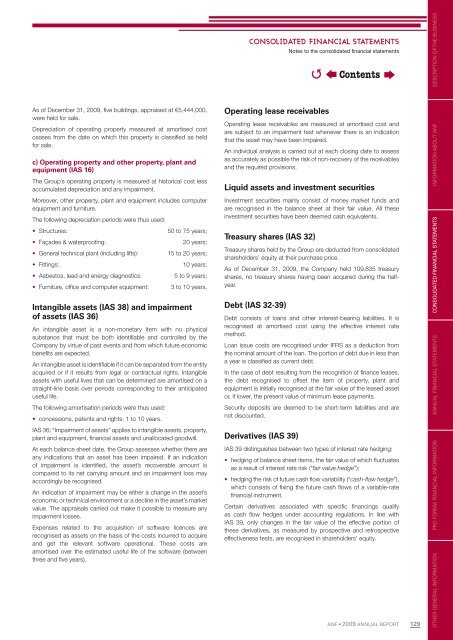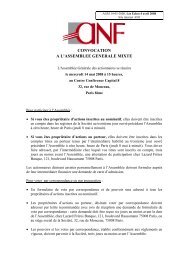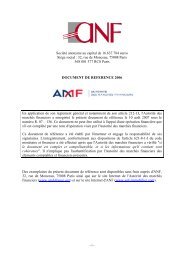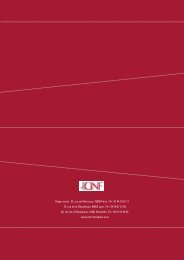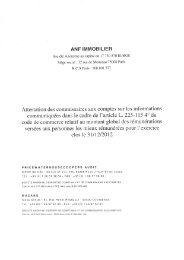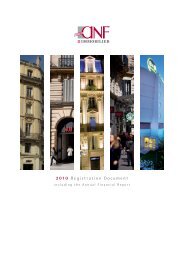Download the 2009 annual report in PDF format - ANF
Download the 2009 annual report in PDF format - ANF
Download the 2009 annual report in PDF format - ANF
You also want an ePaper? Increase the reach of your titles
YUMPU automatically turns print PDFs into web optimized ePapers that Google loves.
As of December 31, <strong>2009</strong>, fi ve build<strong>in</strong>gs, appraised at €5,444,000,<br />
were held for sale.<br />
Depreciation of operat<strong>in</strong>g property measured at amortised cost<br />
ceases from <strong>the</strong> date on which this property is classifi ed as held<br />
for sale.<br />
c) Operat<strong>in</strong>g property and o<strong>the</strong>r property, plant and<br />
equipment (IAS 16)<br />
The Group’s operat<strong>in</strong>g property is measured at historical cost less<br />
accumulated depreciation and any impairment.<br />
Moreover, o<strong>the</strong>r property, plant and equipment <strong>in</strong>cludes computer<br />
equipment and furniture.<br />
The follow<strong>in</strong>g depreciation periods were thus used:<br />
• Structures: 50 to 75 years;<br />
• Façades & waterproofi ng: 20 years;<br />
• General technical plant (<strong>in</strong>clud<strong>in</strong>g lifts): 15 to 20 years;<br />
• Fitt<strong>in</strong>gs: 10 years;<br />
• Asbestos, lead and energy diagnostics: 5 to 9 years;<br />
• Furniture, offi ce and computer equipment: 3 to 10 years.<br />
Intangible assets (IAS 38) and impairment<br />
of assets (IAS 36)<br />
An <strong>in</strong>tangible asset is a non-monetary item with no physical<br />
substance that must be both identifi able and controlled by <strong>the</strong><br />
Company by virtue of past events and from which future economic<br />
benefi ts are expected.<br />
An <strong>in</strong>tangible asset is identifi able if it can be separated from <strong>the</strong> entity<br />
acquired or if it results from legal or contractual rights. Intangible<br />
assets with useful lives that can be determ<strong>in</strong>ed are amortised on a<br />
straight-l<strong>in</strong>e basis over periods correspond<strong>in</strong>g to <strong>the</strong>ir anticipated<br />
useful life.<br />
The follow<strong>in</strong>g amortisation periods were thus used:<br />
• concessions, patents and rights: 1 to 10 years.<br />
IAS 36: “Impairment of assets” applies to <strong>in</strong>tangible assets, property,<br />
plant and equipment, fi nancial assets and unallocated goodwill.<br />
At each balance sheet date, <strong>the</strong> Group assesses whe<strong>the</strong>r <strong>the</strong>re are<br />
any <strong>in</strong>dications that an asset has been impaired. If an <strong>in</strong>dication<br />
of impairment is identifi ed, <strong>the</strong> asset’s recoverable amount is<br />
compared to its net carry<strong>in</strong>g amount and an impairment loss may<br />
accord<strong>in</strong>gly be recognised.<br />
An <strong>in</strong>dication of impairment may be ei<strong>the</strong>r a change <strong>in</strong> <strong>the</strong> asset’s<br />
economic or technical environment or a decl<strong>in</strong>e <strong>in</strong> <strong>the</strong> asset’s market<br />
value. The appraisals carried out make it possible to measure any<br />
impairment losses.<br />
Expenses related to <strong>the</strong> acquisition of software licences are<br />
recognised as assets on <strong>the</strong> basis of <strong>the</strong> costs <strong>in</strong>curred to acquire<br />
and get <strong>the</strong> relevant software operational. These costs are<br />
amortised over <strong>the</strong> estimated useful life of <strong>the</strong> software (between<br />
three and fi ve years).<br />
CONSOLIDATED FINANCIAL STATEMENTS<br />
Operat<strong>in</strong>g lease receivables<br />
Notes to <strong>the</strong> consolidated fi nancial statements<br />
Operat<strong>in</strong>g lease receivables are measured at amortised cost and<br />
are subject to an impairment test whenever <strong>the</strong>re is an <strong>in</strong>dication<br />
that <strong>the</strong> asset may have been impaired.<br />
An <strong>in</strong>dividual analysis is carried out at each clos<strong>in</strong>g date to assess<br />
as accurately as possible <strong>the</strong> risk of non-recovery of <strong>the</strong> receivables<br />
and <strong>the</strong> required provisions.<br />
Liquid assets and <strong>in</strong>vestment securities<br />
Investment securities ma<strong>in</strong>ly consist of money market funds and<br />
are recognised <strong>in</strong> <strong>the</strong> balance sheet at <strong>the</strong>ir fair value. All <strong>the</strong>se<br />
<strong>in</strong>vestment securities have been deemed cash equivalents.<br />
Treasury shares (IAS 32)<br />
Treasury shares held by <strong>the</strong> Group are deducted from consolidated<br />
shareholders’ equity at <strong>the</strong>ir purchase price.<br />
As of December 31, <strong>2009</strong>, <strong>the</strong> Company held 109,835 treasury<br />
shares, no treasury shares hav<strong>in</strong>g been acquired dur<strong>in</strong>g <strong>the</strong> halfyear.<br />
Debt (IAS 32-39)<br />
Debt consists of loans and o<strong>the</strong>r <strong>in</strong>terest-bear<strong>in</strong>g liabilities. It is<br />
recognised at amortised cost us<strong>in</strong>g <strong>the</strong> effective <strong>in</strong>terest rate<br />
method.<br />
Loan issue costs are recognised under IFRS as a deduction from<br />
<strong>the</strong> nom<strong>in</strong>al amount of <strong>the</strong> loan. The portion of debt due <strong>in</strong> less than<br />
a year is classifi ed as current debt.<br />
In <strong>the</strong> case of debt result<strong>in</strong>g from <strong>the</strong> recognition of fi nance leases,<br />
<strong>the</strong> debt recognised to offset <strong>the</strong> item of property, plant and<br />
equipment is <strong>in</strong>itially recognised at <strong>the</strong> fair value of <strong>the</strong> leased asset<br />
or, if lower, <strong>the</strong> present value of m<strong>in</strong>imum lease payments.<br />
Security deposits are deemed to be short-term liabilities and are<br />
not discounted.<br />
Derivatives (IAS 39)<br />
�<br />
Contents<br />
IAS 39 dist<strong>in</strong>guishes between two types of <strong>in</strong>terest rate hedg<strong>in</strong>g:<br />
• hedg<strong>in</strong>g of balance sheet items, <strong>the</strong> fair value of which fl uctuates<br />
as a result of <strong>in</strong>terest rate risk (“fair value hedge”);<br />
• hedg<strong>in</strong>g <strong>the</strong> risk of future cash fl ow variability (“cash-fl ow hedge”),<br />
which consists of fi x<strong>in</strong>g <strong>the</strong> future cash fl ows of a variable-rate<br />
fi nancial <strong>in</strong>strument.<br />
Certa<strong>in</strong> derivatives associated with specifi c fi nanc<strong>in</strong>gs qualify<br />
as cash fl ow hedges under account<strong>in</strong>g regulations. In l<strong>in</strong>e with<br />
IAS 39, only changes <strong>in</strong> <strong>the</strong> fair value of <strong>the</strong> effective portion of<br />
<strong>the</strong>se derivatives, as measured by prospective and retrospective<br />
effectiveness tests, are recognised <strong>in</strong> shareholders’ equity.<br />
<strong>ANF</strong> • <strong>2009</strong> ANNUAL REPORT<br />
129<br />
OTHER GENERAL GENERAL INFORMATION PRO FORMA FINANCIAL INFORMATION ANNUAL FINANCIAL STATEMENTS CONSOLIDATED FINANCIAL FINANCIAL STATEMENTS INFORMATION ABOUT <strong>ANF</strong> DESCRIPTION OF THE BUSINESS


